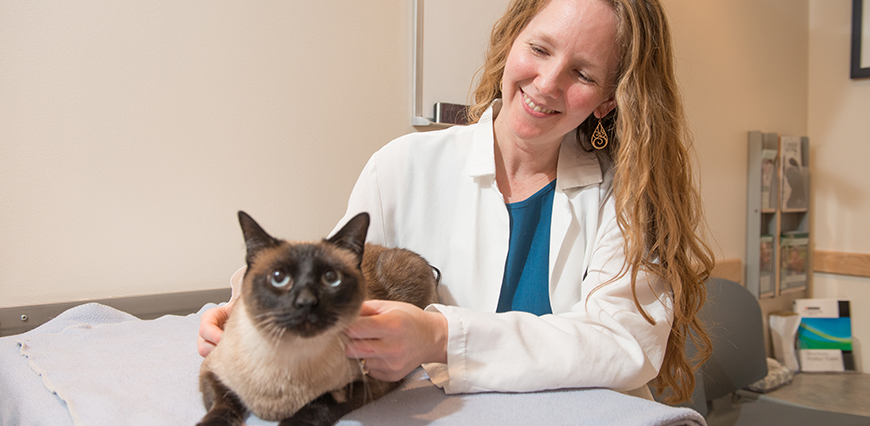
Chronic Kidney Disease
Chronic kidney disease (CKD) is reported in 1-3% of cats with an estimated one-third of cats developing CKD in their lifetime. In the US, 15% of adults, 37 million people, have CKD. In both cases, the disease prevalence increases with age: an estimated 38% of people over 65 years old and approximately 30% to 80% of cats over 15 years old live with CKD. While glomerular disease, damage directly to the glomeruli, is usually the primary cause of CKD in humans and dogs, it is quite rare in cats. In feline patients tubulointerstitial fibrosis, deposition of connective tissue in the functional portions of the kidney, is the primary cause of CKD. However, in all species the final common pathways for CKD is thought to be renal fibrosis and hypoxia. There is no effective treatment that slows the progression of renal fibrosis for either cats or humans. Although there are similarities between the disease in these species, a significant difference exists in the etiology of CKD. In humans, the two primary causes are Type 2 diabetes and hypertension while in cats it is often of idiopathic origin. Disease Etiology:
In humans, the leading cause of CKD is hypertension or diabetes. Diabetes has not been identified as a risk factor for CKD in cats, and hypertension appears to be a complication of CKD in cats rather than an etiology. Several other disease processes are less common but are potential causes of CKD. In both species, congenital kidney malformations, such as polycystic kidney disease, and genetic diseases such as amyloidosis can be a cause of CKD. Neoplasia, immune-mediated inflammation, infections, environmental and drug toxins, and ischemia are all potential etiologies of CKD in both humans and cats. Unlike in humans, many CKD cases in cats are idiopathic in origin with the cat presenting with non-specific tubulointerstitial inflammation and fibrosis. In some areas in Central America, eastern Europe, and south Asia there are reports of idiopathic tubulointerstitial disease in humans as well, particularly in sugar cane workers. It is thought that the high temperatures are causing repeated episodes of acute kidney injury (AKI). As this is the same unique disease presentation in cats, there is indication that chronic dehydration and repeated episodes of AKI might be a cause of CKD in cats. Age related changes such as telomere shortening and loss of repair functions after injury also likely play a role in the development of CKD in cats as CKD incidence increases greatly with age. Generally, idiopathic feline CKD is thought to have multifactorial etiologies likely due to a series of injuries.
Clinical Presentation:
Clinical signs and associated conditions of CKD
| Both | Humans | Cats |
|---|---|---|
| Polyuria | Difficulty sleeping | Poor coat quality |
| Anorexia | Decreased mental acuity | Polydipsia |
| Lethargy | Muscle cramps and twitching | Halitosis |
| Anemia | Edema in the extremities | Constipation |
| Hypertension | GI ulcers | |
| Nausea and vomiting | Persistent itching | |
| Cachexia | ||
| Weight loss | ||
| Renal secondary hyperparathyroidism (metabolic bone disease) | ||
| Hyperkalemia | ||
| Kidney stones (calcium oxalate) | ||
| Pyelonephritis | ||
| Proteinuria | ||
| Hyperphosphatemia |
Diagnosis:
Diagnostics to identify and stage CKD are remarkably similar in humans and cats. Blood tests for BUN and creatinine levels and urinalyses assessing specific gravity and proteinuria are performed in both species. Hypertension is strongly associated with CKD, so routine blood pressure monitoring is performed in cats and humans. Imaging, such as radiographs and ultrasound, is often the next step to identify gross kidney abnormalities. The glomerular filtration rate and kidney biopsies to determine the cause of CKD are often used in human diagnostics but are less frequently performed in cats. SDMA is a new biomarker used in veterinary medicine as it detects CKD earlier and with more accuracy than traditional creatinine tests. Ongoing studies work to determine if SDMA is a reliable biomarker for detecting CKD in humans. If found to be accurate in humans, it would greatly improve detection and monitoring as one of the best tests today is GFR which is time-consuming and requires that the patient be exposed to radioactive materials. Additionally, studies in cats and humans have been conducted indicating that urinary cytokines might serve as an indirect measure of renal inflammation which directly correlates to kidney function thus serving as a non-invasive diagnostic for CKD progression. It is extremely important to diagnose CKD early in both humans and cats because as CKD progresses the damage to the kidneys becomes more severe and irreversible. It is estimated that as many as 90% of people with CKD are not aware that they have the disease. Therefore, finding non-invasive ways to routinely monitor for CKD allows early diagnosis when interventions are most effective.
Treatment:
Chronic kidney disease is a serious and life-threatening disease in both humans and cats. CKD is the number one cause of death in geriatric cats, and the median survival time for cats with CKD varies between one month and three years, depending on the stage. In humans, CKD increases the risk of early death, and 240 people on dialysis die every day. Additionally, two in one thousand people live on dialysis or with a kidney transplant. Treatments have traditionally focused on managing symptoms and slowing disease progression and have include diet changes to decrease phosphorous, medications to lower blood pressure, medications to treat anemia, phosphate-binders, and RAAS inhibitors. Symptom management in cats often includes subcutaneous fluids, anti-nausea medications, and appetite stimulants. For severe cases, dialysis and kidney transplants are used primarily in humans and less commonly in cats. Dogs and humans tend to have proteinuria early in the disease process due to the underlying glomerular disease, so ACE inhibitor and angiotensin receptor blockers are commonly used. Feline patients tend to present with proteinuria later in disease, and there is a specific FDA-approved angiotensin receptor blocker for cats that can be used. While there have been advances and studies in improving disease management, such as finding better therapeutics to treat anemia and better immunosuppressants to aid in kidney transplants, there are also advancements in treatments to stop and slow the advancement of disease. Areas of interest include stem cell therapy to help restore kidney function by repairing tissues. Additionally, CRISPR is being studied as a potential therapy to edit malfunctioning genes when kidney disease stems from a genetic disease.
ABOUT THE AUTHORS
Kara Billington and Tracy Webb
References
Brown, C. A., Elliott, J., Schmiedt, C. W., & Brown, S. A. (2016). Chronic Kidney Disease in Aged Cats: Clinical Features, Morphology, and Proposed Pathogeneses. Veterinary Pathology, 53(2), 309–326. https://doi.org/10.1177/0300985815622975
Habenicht LM, Webb TL, Clauss LA, Dow SW, Quimby JM. Urinary cytokine levels in
apparently healthy cats and cats with chronic kidney disease. J Feline Med Surg. 2013;15(2):99-104. doi:10.1177/1098612X12461007
Jack Lawson, Jonathan Elliott, Caroline Wheeler-Jones, Harriet Syme, Rosanne Jepson,
Renal fibrosis in feline chronic kidney disease: Known mediators and mechanisms of
injury, The Veterinary Journal, Volume 203, Issue 1, 2015, Pages 18-26, ISSN 1090-0233, https://doi.org/10.1016/j.tvjl.2014.10.009.
Lawson JS, Liu HH, Syme HM, Purcell R, Wheeler-Jones CPD, Elliott J. The cat as a naturally occurring model of renal interstitial fibrosis: Characterization of primary feline proximal tubular epithelial cells and comparative pro-fibrotic effects of TGF-β1. PLoS One. 2018;13(8):e0202577. Published 2018 Aug 23. doi:10.1371/journal.pone.0202577
McLeland SM, Cianciolo R, Duncan C, Quimby JM. A comparison of biochemical and
histopathologic staging in cats with chronic kidney disease. Vet Path 2015:52(2):524-534.
McLeland S, Quimby J, Lappin MR. Alpha-enolase staining patterns in the renal tissues of cats
with and without chronic kidney disease. Publication in review, 2018.
McLeland SM, Lunn KF, Duncan CG, Refsal KR, Quimby JM. Relationship between serum
creatinine, serum gastrin, calcium-phosphorus product and uremic gastropathy in cats with chronic kidney disease. J Vet Int Med 2014;28(3):827-837.
Quimby JM, Dow SW. Novel treatment strategies for feline chronic kidney disease: A critical look at the potential of mesenchymal stem cell therapy. Vet J. 2015;204(3):241-246. doi:10.1016/j.tvjl.2015.04.007
Quimby JM. Feline chronic kidney disease: understanding pathophysiology is the key to
development of new treatments. Vet J 2015; 203(3):265-266. DOI: 10.1016/j.tvjl.2014.12.019.
Quimby JM, Maranon DG, Battaglia CL, McLeland SM, Brock WT, Bailey SM. Feline chronic
kidney disease is associated with shortened telomeres and increased cellular senescence. Am J Physiol Renal Physiol. 2013;305(3):F295-F303. doi:10.1152/ajprenal.00527.2012
Quimby JM, Webb TL, Gibbons DS, et al. Evaluation of intrarenal mesenchymal stem cell injection for treatment of chronic kidney disease in cats. J Feline Med Surg 2011;13(6):418.
Quimby JM, Webb TL, Habernicht L, et al. Safety and efficacy of intravenous infusion of allogeneic cryopreserved mesenchymal stem cells for treatment of chronic kidney disease in cats: Results of three sequential pilot studies. Stem Cell Research and Therapy 2013;4(2):48.
Quimby JM, Webb TL, Randall E, et al. Assessment of intravenous adipose-derived allogeneic mesenchymal stem cells for the treatment of feline chronic kidney disease: a randomized, placebo-controlled clinical trial in 8 cats. J Feline Med Surg 2015;8(2):165.
Summers S, Quimby JM, Isaiah A, Suchodolski JS, Lunghofer PJ, Gustafson DL. The fecal
microbiome and serum concentrations of indoxyl sulfate and p-cresol sulfate in cats with chronic kidney diseases. Accepted for publication in J Vet Intern Med, 10/30/18.
Thomson AL, Berent AC, Weisse C, et al. Intra-arterial renal infusion of autologous mesenchymal stem cells for treatment of chronic kidney disease in cats: Phase 1 clinical trial. J Vet Intern Med 2019;33(3):1353.
Vidane AS, Pinheiro AO, Casals JB, et al. Transplantation of amniotic membrane-derived multipotent cells ameliorates and delays the progression of chronic kidney disease in cats. Reprod Domest Anim 2017;52 Suppl 2:316.



